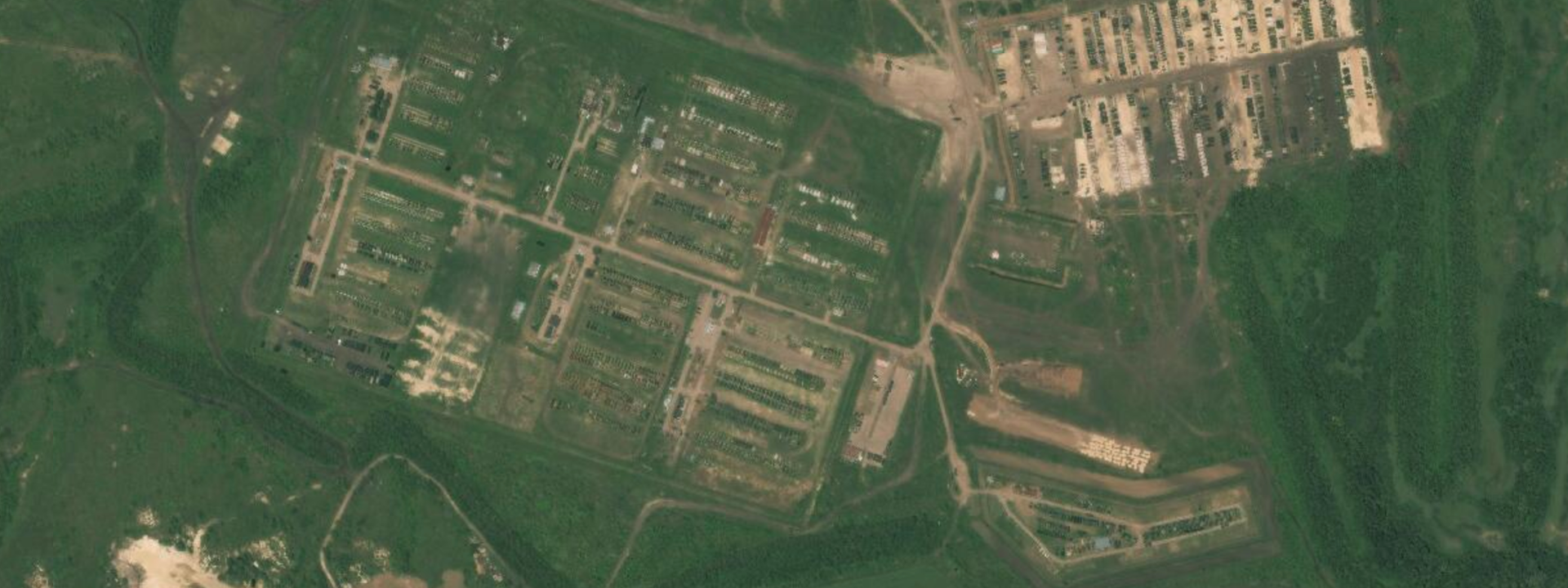Images and Activity: Russian Military Bases on Ukraine’s Eastern Border
Russia’s massive military presence bordering the non-government-controlled areas of easternUkraine
Images and Activity: Russian Military Bases on Ukraine’s Eastern Border

Russia’s massive military presence bordering the non-government-controlled areas of eastern Ukraine

Two months ago, @DFRLab reported on the potential of an increased Russian military presence along Ukraine’s eastern border with a newly completed railway line and sightings by various sources on social media. Thanks to new imagery from DigitalGlobe, @DFRLab took a closer look at recent developments at Russian military bases along Ukraine’s eastern border.
Background: Russian Forces in Ukraine
The Russian military presence in eastern Ukraine was and still is debated since the outbreak of the conflict in 2014. Russia denied any military presence in the so-called Luhansk and Donetsk People’s Republic (LNR and DNR), but evidence of Russian forces in the Donbas emerged through a variety of sources, creating a comprehensive picture of a Russian military presence in eastern Ukraine. Evidence hidden in plain sight ranged from surface-to-air missiles to Russian soldiers’ selfies in non-government-controlled Ukrainian territory. Eventually, Russian President Vladimir Putin’s rhetoric changed, and it is now largely recognized that the “separatists” are led and heavily supported by the Russian Federation.

The Organization for Security and Co-operation in Europe’s Observer Mission (OSCE OM) at Russian Checkpoints Gukovo and Donetsk regularly report traffic at two major international border crossing points between non-government-controlled Ukraine and Russia. In the OSCE OM’s weekly update dated October 17, the mission observed an increased level of traffic, with approximately 70 percent of the “persons in military-style outfits” crossing at the Donetsk border crossing point (BCP). The OM tends to observe a higher amount of “persons in military-style outfits” crossing into Ukraine as opposed to crossing into the Russian Federation.
After the Trilateral Contact Group (TCG) meetings in Minsk on October 18, Special Representative of the OSCE Chairperson-in-Office in Ukraine and in the TCG Ambassador Martin Sajdik reported that increased levels of kinetic activity and ceasefire violations are cutting off critical infrastructure such as electricity and water. Recently increased numbers of ceasefire violations as reported by the Organization for Security and Co-operation in Europe’s Special Monitoring Mission (OSCE SMM) to Ukraine correspond to recently increased traffic of “persons in military-style outfits.”
Today: Russian Forces in Ukraine
According to July 2017 information released by the Ukraine Crisis Media Center (UCMC), there are approximately 2,900 Russian regular soldiers and 36,300 Russian proxy forces “constantly” in eastern Ukraine, operating on a rotational basis. UCMC reported that Russian forces in Ukraine are composed from the 331st Airborne Regiment based out of Kostroma, Kostroma Oblast, Russia, 20th Motorized Infantry Brigade based in Volgograd, Volgograd Oblast, Russia, and the 7th Air Assault Division based in Novorossiysk, Krasnodar Krai, Russia.

In another infographic, UCMC compares the amount of tanks, artillery and multiple launch rocket systems (MLRS or MRLS), armored fighting vehicles (AFV), and anti-aircraft warfare systems (AAW). As the graphic clearly illustrates, the numbers of heavy military equipment recorded in eastern Ukraine dramatically outnumber the amount in the so-called Luhansk and Donetsk People’s Republics in 2014.

Boguchar
In a previous report, @DFRLab drew attention to the growing 262nd Russian equipment base and 1st Separate Tank Brigade in Boguchar, Voronezh Oblast, Russia. In satellite imagery from DigitalGlobe, details of military vehicles and equipment, such as towed artillery and camouflage can be identified.

MBTs and towed artillery are notable for two reasons — as @DFRLab’s #ZapadWatch series reported, MBTs comprised a substantial part of the joint Russian-Belarusian military exercises under Zapad 2017; and MBTs and towed artillery are heavily used and responsible for heavy weapons violations (with the equipment pictured likely 120mm mortars, 122mm artillery, and 125mm cannons) to the Minsk agreements along the line of contact in eastern Ukraine.
In the DigitalGlobe satellite imagery below, likely towed artillery (blue boxes) was moved from the Boguchar base between June 30-July 18, 2017. Its current location is unknown, and it is uncertain that the equipment is in Ukraine, but it is possible. In addition to artillery, it appears several main battle tanks were uncovered (pink boxes), indicating potential recent activity.


Kamensk-Shakhtinsky
A Russian military base located in Kamensk-Shakhinsky, Rostov Oblast, Russia 30km east of the aforementioned heavily trafficked Donetsk Russia-Ukraine international border crossing point has also seen significant activity since the outbreak of the conflict. DigitalGlobe satellite imagery shows a substantial increase in the number of military vehicles at the base, which suggests increased activity.

Chkalova
In satellite imagery of another Russian military base previously reported on by @DFRLab and 100km from the Maksimov border crossing point at Ukraine’s eastern border in Chkalova, Rostov Oblast, military positions similar to the ones seen in eastern Ukraine are clustered around a base. Entrenchment and fortifications of this style are prevalent on both sides of the contact line, indicative of the presence of weapons banned by the Minsk agreements. Given the location of the base and large amount of military vehicle tracks, these positions are likely training ranges.


Conclusion
Russian military activity along Ukraine’s eastern border remains significant. Ceasefire violations by heavy weapons banned by the Minsk agreements continue to be a prevalent issue in the conflict in eastern Ukraine, wreaking havoc on civilian life and causing civilian casualties, destroying residential areas, and damaging critical infrastructure. As the OSCE SMM regularly reports, civilians are frequently caught in the crossfire, being hit by explosions and sustaining shrapnel injuries. With detailed satellite imagery taken incrementally over time, it is possible to shed light on what Russian military bases activity and what equipment they may be deploying across the border with Ukraine.
Follow the latest Minsk II violations via the @DFRLab’s #MinskMonitor.
Also, follow @DFRLab on Twitter for more in-depth analysis from our #DigitalSherlocks.

